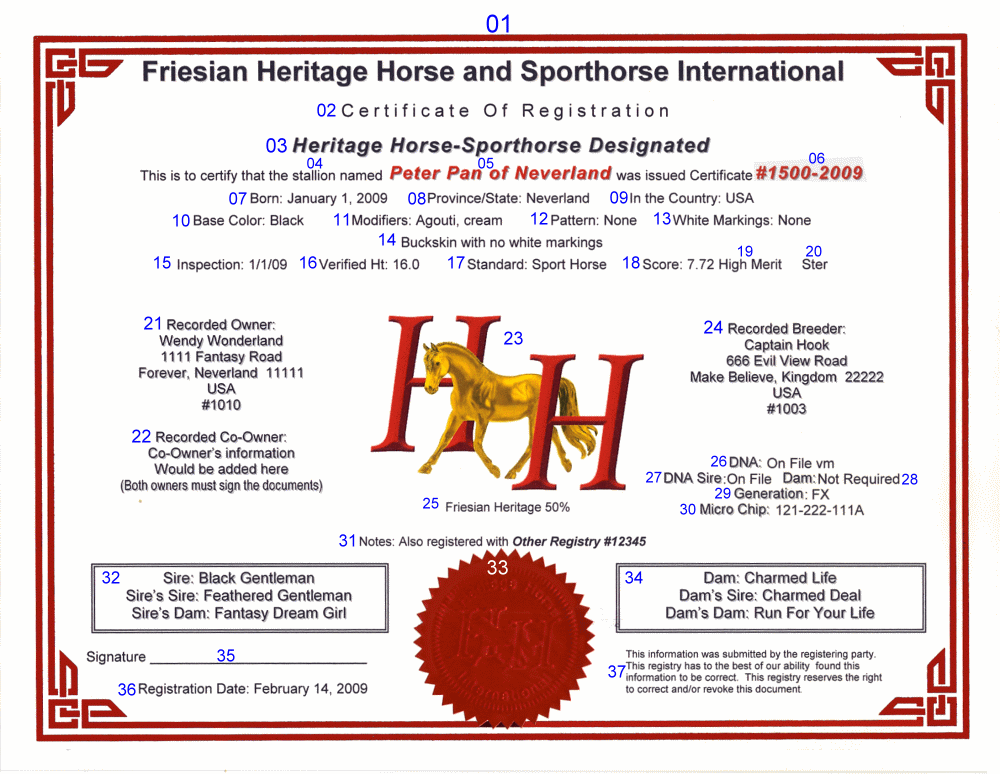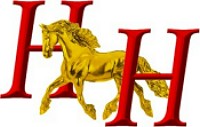
|
About the Friesian Heritage Horse papers Below is a Click on any number or title to view the descriptons below
|

| 01 Border |
The border of our paper represent a designation of type after a horse had completed the inspection process, the border is red on our standard paper and normally the inspection area is blank. However if the horse has complete and has a qualifying score on the Utility standard this information is filled in. |
||
| 02 Certificate Type |
This area is for listing
Foundation Sires or Dams. Recorded. Or generally certificate of
registration. Note: Most registries allow horses to be double registered. This certificate is for horses of 25% to 100% Friesian ancestry who are already registered elsewhere and not allowed to double register. (Usually, Foreign Registries) |
||
| 03 Designation | The options listed below are available to horses who have completed a HH recognized inspection with a qualifying score and/or have achieved specific requirements in open competition. Horses being registered with HH for the first time may apply directly for the Advanced Registration Papers if the criteria has been met. | ||
| 04 Sex of Horse | If the horse was registered as a foal the paper will say filly or colt. If the horse was registered as a two year old or older at the time of registration the papers will say, stallion, mare or gelding. | ||
| 05 Horses Name |
Your choice of a registered name One-word names are typically not allowed. You may use a farm name like Peter Pan of Neverland Ranch or Peter P or Peter NLR. Please provide at least two name options. Do not use punctuation marks or numbers in the name choices. Names may not exceed 30 characters (spaces included). This rule does not apply to purebred Friesian who have FPS or FPZV papers. The HH reserves the right to disallow the use of names already commonly established by another farm as their “trade-name”(s). Well-known sire names may not be used in the name, unless the horse is directly related to the sire and/or written permission is given by sire owner. Sire names may not be used at the beginning of a name, unless the horse is a direct son or daughter of that sire, or written permission is given by sire owner. |
||
| 06 Certificate Number | This number is assigned by the HH registry. The first portion is the number that identifies the horse. The last four number are the horses date of birth. | ||
| 07 Date Foaled | This is the date that the was born. If the exact date is not known the space will say aprx. meaning this is an approximate date. | ||
| 08 Province or State Born | In some circumstances a town may be list as is the case in foreign addresses | ||
| 09 Country | We register horse from any country outside of the USA. This field refers to the horse birth origin. | ||
| 10 Base Color | The base color of a horse can only be black or red. Every other color is caused by modifiers and or patterns | ||
| 11 Modifiers |
This area will list the modifiers that are inherited by the horse that influence the horse physical appearance. Example if the horse is red based and inherits a cream gene, making the horse appear as a palomino, cream will be listed as a modifier. Some of the common modifiers are Dun, gray, cream, silver, champagne and the most common agouti (the bay gene) There is an extensive list of the most common modifiers on our registration application. The Agouti (Bay) gene is the most common gene and it always effects a black based horse and make the horse a bay. A red based horse does not "show" effects of the agouti gene as it does nothing to red based coat colors. A red based horse may carry the agouti gene, and it could show its inheritance in a black based foal. A black horse can not produce a bay foal. A chestnut (that carries a bay gene) or bay horse can. The gray gene is the trump card gene. If this gene is inherited will turn every horse gray and eventually white. |
||
| 12 Patterns |
There are only two patterns for horses. The pinto patterns and the Lp pattern (commonly referred to as the appaloosa pattern) The pinto pattern group includes: Tobiano, overo, sabino, splash............ The Lp pattern group describes different way this pattern may be expressed. Leopard, near leopard, snow cap, few spot etc. There is also the pintaloosa pattern which is a combination of the two patterns mentioned above. |
||
| 13 White Markings | This refers to white face and leg markings, and not pattern white markings. However, on a pinto horse these marking are not visible, or can be difficult to determine because of the pinto pattern. | ||
| 14 Description Line | This line is a written description of how the horse appears in commonly used horse industry terminology. | ||
| 15 Inspection Date | This date is the date that the horse was inspected. | ||
| 16 Verified Height |
This height is given at an inspection after the horse is typically 3 years old or over. This height is given by an inspection official. A verified height is not added to the registration documents unless it is a verified height. Owners may not submit this information for addition to this document. |
||
| 17 Standard Type | Sport Horse standard, Purebred standard, Park standard and Utility standard. | ||
| 18 Score | |||
| 19 Premium | Blue, Red, Yellow, High Merit | ||
| 20 Ster | Riding test | ||
| 21 Recorded Owner & Number | |||
| 22 Recorded Co-Owner | |||
| 24 Recorded Breeder & Number | |||
| 23 HH Logo |
 This is the logo is used on all horse who are not 100% Friesian heritage. Horses that are purebred Friesians will have a different logo that has a Friesian horse in the red H's on their certificate of registration. (Example on right) |
||
| 25 Percent of Friesian heritage | |||
| 26 DNA |
When a horse does not have DNA on file, “NOF” or “Not on File” will be written on their papers to indicate that DNA testing has not been done on that particular horse. When a horse does have DNA on file, the papers will state “DNA On File” to indicate that that particular horse has submitted a DNA sample. For horses who are not DNA tested themselves, but have a parent(s) with DNA on file, it will state in the DNA notes section, of the horse’s certificate, that the parent(s) has DNA on file with HH. If the horse has been DNA tested and verified against its Friesian heritage parent/s the papers will say DNA on file with a "v" for the sire and a "m" for the dam after the DNA has been matched. |
||
| 27 DNA Sire | |||
| 28 DNA Dam | |||
| 29 Generation | PB Denotes a Purebred Friesian Horse. FX Denotes a Horse of Friesian Heritage. | ||
| 30 Micro Chip | Any micro chip implanted in the horse | ||
| 31 Notes | Other registries. Or other pertinent notes | ||
| 32 Sire | |||
| 33 Official Seal | This is the official embossed seal issued by the Heritage Horse Registry it depicts | ||
| 34 Dam | |||
| 35 Signature | Only an official HH Council member may sign this or any other HH document. | ||
| 36 Registration Date | This is the horses permanent registration date | ||
| 37 Disclaimer | |||